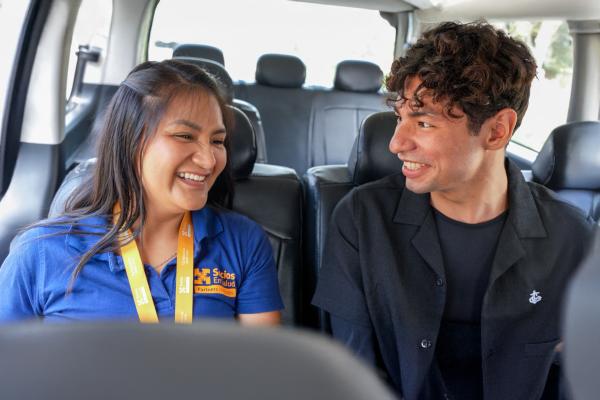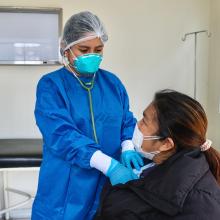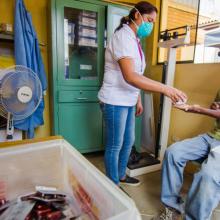In December 2023, Kioshi Vasquez, a 19-year-old living in Lima, Peru, was at work when he started coughing. He didn’t feel it like any other cough. When he brought his hand to his mouth, he saw traces of blood that left him alarmed.
“I went as an emergency to the hospital. They told me it was nothing serious, so they gave me an injection to stop the bleeding and hemorrhaging. And there it stayed,” he recalls.
That day they suggested she have an additional test to rule out tuberculosis (TB). He underwent several tests, all with the same result: negative. However, the cough persisted. And so did the blood.
“I was very scared, because I didn’t know what I had,” he admits. “I didn’t tell anyone at work, because I thought I might get fired.”
Kioshi had no one to turn to. He had been living alone for some time after going through family problems and becoming estranged from home. The independence he had sought now felt overwhelming. So he decided to have an X-ray. A few days before Christmas he was given the diagnosis: tuberculosis.
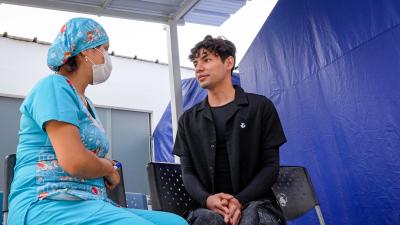
Kioshi Vásquez, 20 años. Enfrentó la tuberculosis multidrogorresistente (TB-MDR) con determinación desde su diagnóstico a finales de 2023.
Foto de Diego Díaz / SES
“At that moment, I, well… I said now what do I do. I live alone, I don’t know what to do,” he says.
After having more tests to determine the type of infection, he learned that his tuberculosis was resistant to a drug. “I became MDR,” he says, referring to multidrug-resistant tuberculosis (MDR-TB), one of the most difficult-to-treat forms of the disease.
In Peru, one of the countries with the highest burden of tuberculosis in Latin America, about 1,500 cases of MDR-TB are detected each year, according to the Ministry of Health (MINSA). Globally, many people are not even diagnosed in time. The Pan American Health Organization (PAHO) states that of the 400,000 who developed MDR-TB, in 2023, only 44% received a diagnosis and access to treatment.
Kioshi belongs to that group that managed to get a diagnosis, but receiving the news did not mean the path was clear. MDR-TB involved longer and more aggressive treatment, lasting up to two years that included two to three daily injections and taking hundreds of pills. “It was very difficult, really, very difficult,” he says.
The accompaniment that made the difference
Living in Carabayllo, a district north of Lima, Kioshi was referred to the Raul Porras Barrenechea Health Center to begin his treatment. Proximity facilitated his access, but on the first day he did not show up.
“I didn’t really go until the nurse in charge called me and told me that I had to go, or my disease could get worse,” she admits. “I won’t deny that there were times when I didn’t go, because I had to go every day and I had to work and I didn’t have the time. But inside me I knew I had to recover and not just give up.”
That’s when Socios En Salud (SES) came in contact with him.
Since 2022, SES has been developing Elimination of TB, a comprehensive strategy to combat tuberculosis in key areas such as Carabayllo and Metropolitan Lima. The initiative is based on three fundamental pillars: search, treatment and prevention.
To detect TB cases early, the team carries out active search activities in vulnerable populations, using portable X-rays and molecular tests. But the effort does not end with diagnosis. The approach also contemplates accompaniment during treatment, ensuring that the affected person continues until recovery.
This work is carried out in close coordination with MINSA health centers, such as Raúl Porras Barrenechea. In 2024 alone, the intervention of Socios En Salud enabled the detection of 81 cases of latent TB, 29 of susceptible TB and 3 of MDR-TB in Carabayllo.
“We intervened (in Kioshi’s treatment) when the nurse informed us about her case,” explains Hilda Valdivia, nursing technician for the project.
For Kioshi, that support made a difference. As he grappled with the impact of the diagnosis and the side effects of treatment, which left him deeply exhausted, unwilling to continue, he began receiving home visits from the Socios En Salud team.
“We would monitor his treatment, get to know how he was feeling, identify his needs and assess what kind of support we could offer him. We also went to the health facility to coordinate their requirements, whether it was for tests or medical consultations,” says Valdivia.
The accompaniment not only ensured that she followed her treatment, but also addressed social difficulties that could jeopardize her recovery. “Through the Social Protection Program, at some point she was supported with groceries, clinical evaluations and constant psychological accompaniment,” adds the nursing technician.
Over time, the fear and uncertainty with which Kioshi began her treatment began to dissipate. He still had a way to go, but he was no longer alone. “Socios En Salud helped me a lot in the time where I was without anyone,” he says.
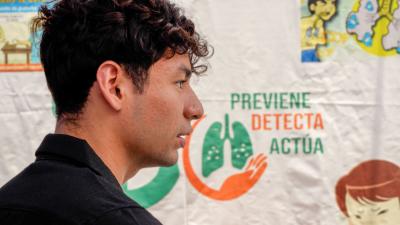
Kioshi contó con el acompañamiento del equipo de Eliminación de la TB, del Programa de TB de Socios En Salud, que le brindó víveres, soporte psicológico y otras formas de apoyo clave para continuar con su tratamiento.
Foto de Diego Díaz / SES
The strength to keep going
If he can salvage anything from everything he’s been through, Kioshi acknowledges that the disease left him with a lesson. “(Tuberculosis) made me really rethink who I am and how I am with others,” he reflects.
Like many people affected by the disease, for many moments he was afraid to tell those around him that he had been diagnosed with TB. From his family members to the landlady from whom he rented the room where he lives to his co-workers.
“It was only my partner who knew at the time. He would help me when I was going through emergency cases. And I had a cat, so my support was my kitty and my partner,” she recounts.
After a month and a half of receiving daily injections, the National Retreatment Evaluation Committee (CNER), a MINSA body responsible for evaluating complex TB and MDR-TB cases, decided that Kioshi should follow a shortened treatment that is completely oral.
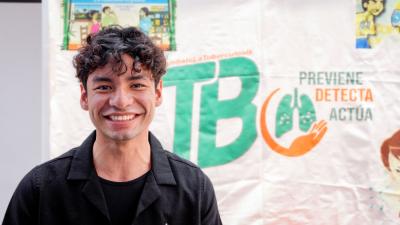
Este año, Kioshi fue dado de alta tras su diagnóstico de TB-MDR. Su historia refleja el poder del acompañamiento en el camino hacia la recuperación.
Foto de Diego Díaz / SES
This 2025, after undergoing a sputum culture, Kioshi tested negative for TB and was medically discharged. “I’m back to physical activity, because I’ve been a year without doing absolutely no sports. But without exerting myself too much, just enough,” he says.
Today, at 20 years old, this young man looks ahead with a different perspective. Overcoming MDR-TB meant not only regaining his health, but also discovering his own resilience. His story is a testament to how TB remains a challenge, but also how, with timely diagnosis, proper treatment and accompaniment, recovery is possible.
“I have had many casualties, it has been very difficult for me to control situations, but in the long or short run you can. My advice is to hang in there and keep going,” she says.
Be part of the change. Receive in your inbox our actions, stories and opportunities to transform lives. Subscribe hereand join our health movement!
.
